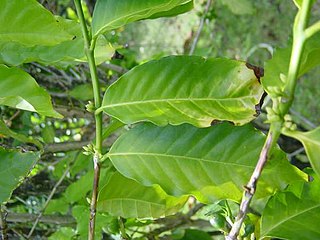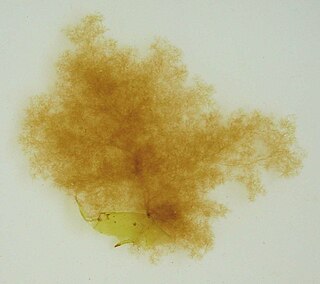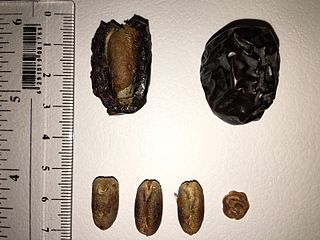
A larva is a distinct juvenile form many animals undergo before metamorphosis into adults. Animals with indirect development such as insects, amphibians, or cnidarians typically have a larval phase of their life cycle.

Phoenix dactylifera, commonly known as date or date palm, is a flowering plant species in the palm family, Arecaceae, cultivated for its edible sweet fruit called dates. The species is widely cultivated across northern Africa, the Middle East, and South Asia, and is naturalized in many tropical and subtropical regions worldwide. P. dactylifera is the type species of genus Phoenix, which contains 12–19 species of wild date palms.

A melon is any of various plants of the family Cucurbitaceae with sweet, edible, and fleshy fruit. The word "melon" can refer to either the plant or specifically to the fruit. Botanically, a melon is a kind of berry, specifically a "pepo". The word melon derives from Latin melopepo, which is the latinization of the Greek μηλοπέπων (mēlopepōn), meaning "melon", itself a compound of μῆλον (mēlon), "apple, treefruit " and πέπων (pepōn), amongst others "a kind of gourd or melon". Many different cultivars have been produced, particularly of cantaloupes.

The citron is a large fragrant citrus fruit with a thick rind. It is one of the original citrus fruits from which all other citrus types developed through natural hybrid speciation or artificial hybridization. Though citron cultivars take on a wide variety of physical forms, they are all closely related genetically. It is used in Asian cuisine, traditional medicines, perfume, and religious rituals and offerings. Hybrids of citrons with other citrus are commercially more prominent, notably lemons and many limes.

Bourbon is a cultivar of Coffea arabica. It is one of the two main cultivars from which many new cultivars are bred, the other being Typica. Both originated in Yemen.
Time geography or time-space geography is an evolving transdisciplinary perspective on spatial and temporal processes and events such as social interaction, ecological interaction, social and environmental change, and biographies of individuals. Time geography "is not a subject area per se", but rather an integrative ontological framework and visual language in which space and time are basic dimensions of analysis of dynamic processes. Time geography was originally developed by human geographers, but today it is applied in multiple fields related to transportation, regional planning, geography, anthropology, time-use research, ecology, environmental science, and public health. According to Swedish geographer Bo Lenntorp: "It is a basic approach, and every researcher can connect it to theoretical considerations in her or his own way."

The palm weevil Rhynchophorus ferrugineus is one of two species of snout beetle known as the red palm weevil, Asian palm weevil or sago palm weevil. The adult beetles are relatively large, ranging between 2 and 4 centimetres long, and are usually a rusty red colour—but many colour variants exist and have often been classified as different species. Weevil larvae can excavate holes in the trunks of palm trees up to 1 metre (3.3 ft) long, thereby weakening and eventually killing the host plant. As a result, the weevil is considered a major pest in palm plantations, including the coconut palm, date palm and oil palm.

Discoscaphites is an extinct genus of ammonite. This genus may have been one of the few to have briefly survived the K-Pg mass extinction.

Ectocarpus siliculosus is a filamentous brown alga. Its genome was the first brown macroalgal genome to be sequenced, with the expectation that E. siliculosus will serve as a genetic and genomic model for brown macroalgae.

Macapuno or coconut sport is a naturally occurring coconut cultivar which has an abnormal development of the endosperm. The result of this abnormal development is a soft translucent jelly-like flesh that fills almost the entire central cavity of coconut seeds, with little to no coconut water. Macapuno was first described scientifically from wild specimens in 1931 by Edwin Copeland. They were cultivated commercially in the Philippines after the development of the "embryo rescue" in vitro culture technology in the 1960s by Emerita V. De Guzman. It has become an important crop in coconut-producing countries and is now widely used in the cuisines of Southeast Asia and the Pacific Islands.

Prof. Dr. Shri Mohan Jain is an Indian-born plant biotechnology scientist. He worked several years for the International Atomic Energy Agency in Vienna. He has done research on genetically modified food, mutation breeding, ornamental plants, date palm, and tropical fruit, such as banana. He has edited 44 internationally sold books.
Plant cryopreservation is a genetic resource conservation strategy that allows plant material, such as seeds, pollen, shoot tips or dormant buds to be stored indefinitely in liquid nitrogen. After thawing, these genetic resources can be regenerated into plants and used on the field. While this cryopreservation conservation strategy can be used on all plants, it is often only used under certain circumstances: 1) crops with recalcitrant seeds e.g. avocado, coconut 2) seedless crops such as cultivated banana and plantains or 3) crops that are clonally propagated such as cassava, sweet potato.
Zahidi is a cultivar of the palm date that originated in Iraq. It has light brown skin. It is a semi-dry date of medium size that is very sweet. Zahidi dates ship well and are widely exported.

Ajwa is a cultivar of the palm date that is widely grown in Medina, Saudi Arabia. It is an oval-shaped, medium-sized date with black skin. It is often consumed during Ramadan and Islamic religious events, since it is traditionally associated with the prophet Muhammad.
Fard or fardh is a cultivar of the palm date that is widely grown in Oman. It has black skin and small seeds. Fard dates ship well and do not tend to developed wrinkled skin.

Khalas is a cultivar of the palm date that is widely grown in eastern Saudi Arabia and the Persian Gulf region. It has brown skin.

Mabroom is a cultivar of the palm date that is widely grown in Saudi Arabia. It is a large, elongated date similar to the Piarom cultivar.
Rabbi is a cultivar of the palm date that is widely grown in Iran as well as in Pakistan. It has an elongated shape, and its skin has a reddish hue. As a semi-dry date, it can be stored for long periods of time due to its low moisture content.














